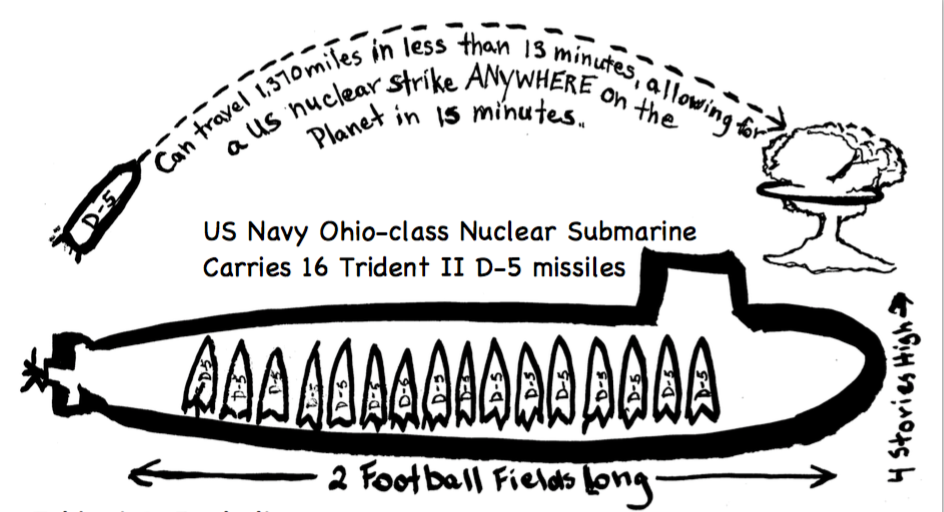Fact Sheet

-
The 130,000-pound Trident II D5 missile can travel 20,000-feet per second, according to Navy figures. The missiles cost $30 million each.
-
The Trident II D5 missile is deployed aboard U.S. Navy Ohio-class submarines and Royal Navy Vanguard-class. The three-stage ballistic missile can travel a nominal range of 4,000 nautical miles and carry multiple independently targeted reentry bodies.
-
The “Bulletin of the Atomic Scientists” further describes the weapon — “The Trident D5s carry three types of warheads: the 100-kiloton W76/Mk-4, the 100-kiloton W76-1/Mk-4A, and the 455-kiloton W88/Mk-5 warhead, the highest-yield ballistic missile warhead in the U.S. arsenal.”
-
The Navy is modernizing its arsenal of Trident II D5 nuclear missiles in order to ensure their service life can extend for 25 more years aboard the Navy’s nuclear ballistic missile submarine fleet. The 44-foot long submarine-launched missiles have been serving on Ohio-class submarines for 25 years.
-
The missiles are also being planned as the baseline weapon for the Ohio Replacement Program ballistic missile submarine, a platform slated to serve well into the 2080s, so the Navy wants to extend the service life of the Trident II D5 missiles to ensure mission success in future decades. (The National Interest Jan. 2, 2017.)
-
Trident submarines serve as the sea based nuclear launch system of the Air, Land, and Sea Nuclear Triad supported by the US government. The U.S. currently has 14 nuclear-powered Trident ballistic-missile (SSBN) submarines. Trident submarines are 560 feet in length, or nearly two football fields. Each submarine can carry 24 submarine-launched ballistic missiles (SLBMs) designated Trident D5 and each missile can carry up to eight 100 kiloton nuclear warheads (about 30 times the explosive force as the Hiroshima bomb).
-
The Trident D5 missile stands 44.6 feet high and originally had a range of 4,230 nautical miles with a full load of warheads, and up to 6000+ nautical miles with a reduced load of warheads. Upgrades and Life Extension Programs may have changed some specifications. Warheads are either Mark-4/W76 or Mark-5/W88.
100: Number of kilotons on ONE Trident W76 warhead
455: Number of kilotons on ONE Trident W88 warhead
345,600: Total number of kilotons deployed on Trident fleet
14: Number of kilotons on atomic bomb that was dropped on Hiroshima
150,000: Number of people killed by the atomic bombing of Hiroshima
1,028 minimum; 4,885 maximum: Number of potential “Hiroshimas” each Trident is capable of destroying
$170,200,000,000 (low estimate): Total cost of the ENTIRE Trident program through year 2042
-
Six Tridents operate out of Kings Bay, GA. The Trident submarines at Kings Bay are likely to be used first in any nuclear attack, either as an isolated tactical assault on a specific site, bunker, or weapons location, or in a larger strategic nuclear attack. The D5 missile is capable of traveling over 1,370 miles in less than 13 minutes, allowing for a US nuclear strike anywhere on planet earth within 15 minutes.
-
The Tridents are getting old, so, according to Defense One, the U.S. Navy is developing a replacement. Even if it comes in on time and on budget, it will be the country’s third most-expensive weapon system ever. It’s known as the Columbia-class submarine, the fifth type of U.S. ballistic missile submarine since the Navy started building them in 1959. Its designs were finished just three years ago; so far, it still only exists on paper.
-
In all, the new Tridents will cost $122.3 billion. Production costs alone will run about $8.2 billion for the first sub, slated to arrive in 2028, and about $6.5 billion for the remaining 11.
